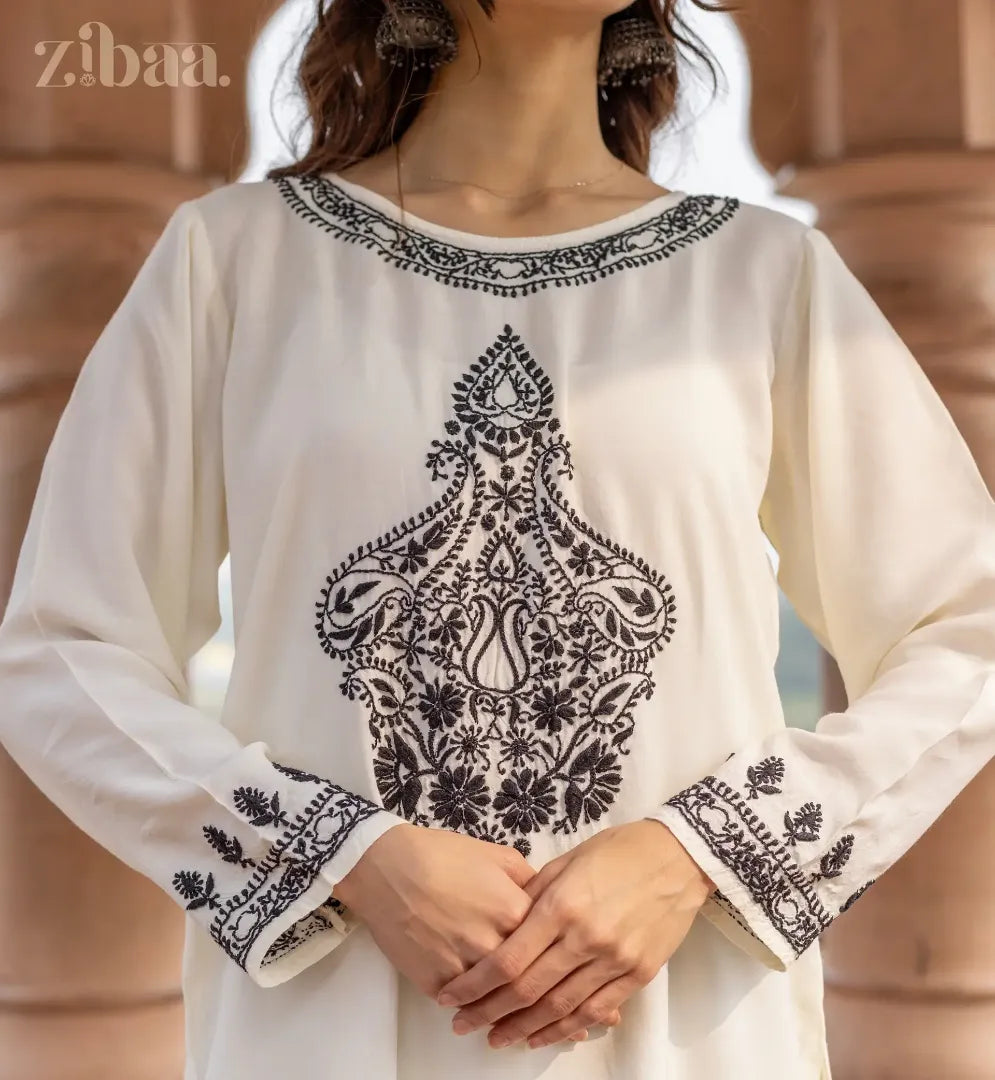Chikankari suits are the epitome of graceful ethnic fashion. But picking the right chikankari suit that complements your body type can be tricky. The wrong silhouettes or styles can make you look broader, shorter or highlight problem areas. So it’s important to understand your body proportions and pick chikankari suit for women accordingly.
Chikankari Suits for the Apple Body Type
Women with an apple body shape tend to have a heavier bust and waist with narrower hips. The aim is to create an hourglass effect by drawing attention to the lower body while balancing the upper body.
For the apple shape, opt for chikankari suits like sharara sets or gharara suits. The flared bottom of sharara pants or gharara flares create the illusion of wider hips. Pair them with slightly fitted or peplum style chikankari kurtas to balance the top. Avoid very tight chikankari kurtas. Stick to V-necks or deep round necks to elongate your torso. Three-fourth, elbow length or short sleeves also suit this body shape. Keep minimal embroidery around the bust to avoid unnecessary bulk.
Flared anarkalis with cinched waistlines work as they highlight the narrowest part of your waist before flaring out. Long chikankari jackets or knee length kurtas help camouflage heavier mid-sections. Avoid cropped or very short jackets. Go for vertical prints, stripes as well as embroidered borders to create a lengthening effect.
Chikankari Suits for the Pear Body Type
Pear body shape refers to women with fuller hips, thighs, and legs paired with a slimmer bust and shoulder line. The goal is to add volume on top while drawing attention away from the bottom heavy lower body.
For pear shaped figures, A-line chikankari kurtas work well compared to very fitted silhouettes. Pair them with churidars rather than loose shararas or ghararas which may over-accentuate fuller lower bodies. Scoop necks, boat necks and square necklines help widen the upper body. Avoid halter necks or off-shoulders. Go for three-fourth, elbow length and long sleeves rather than sleeveless or short sleeves.
Embroidered yokes, embellishments around the neck and shoulders add bulk on top. Heavy work like zardozi or badla around the hemline should be avoided. Jackets and bolero style chikankari kurtas balance out bottom heavy figures too. Long vertical motifs elongate your frame. Contrast chikankari dupattas also help draw attention upwards.
Chikankari Suits for the Hourglass Figure
The ideal body shape, hourglass figures have a defined waist with proportionate bust and hip measurements. Make the most of your curves with the right chikankari suit for women.
Since hourglass figures are quite well balanced, you can experiment with most necklines, sleeve styles and silhouettes. Fitted chikankari kurtas work well to show off your feminine physique. Pair them with slim churidars or pants. Kurtis with cinched waists enhance your natural curves. Princess cut anarkalis that flare slightly at the bottom make for fine choices.
Scoop necks and sweetheart necklines show off your defined collarbones. Three-fourth sleeves balance out bare shoulders. Bold colored or heavily embroidered dupattas can be draped around the waistline to highlight your slimmest part. Avoid boxy and oversized chikankari kurtas. Stick to medium to short lengths which suit hourglass bodies.
Chikankari Suits for Rectangle Figures
Rectangular or ruler body shapes have minimal waist definition with nearly equal bust, hip and shoulder width. The aim is to fake a waist by drawing attention to it.
Fitted chikankari kurtis with side slits, ties or tasseled doris flatter rectangle bodies. Peplum and asymmetrical hemlines also create the illusion of a curvy waist. Pair them with narrow pants or leggings. Avoid loose or baggy silhouettes. Opt for boat neck, V-neck and square necklines over high necks and halter necks. Half sleeves, short sleeves and sleeveless styles help break the straight silhouette.
Embellished yokes, heavy embroidery around the neckline along with bold dupattas worn around the waist bring focus to the area. Short jacket style chikankari kurtis also work well. Avoid chikankari embroidery all over since it will overpower your frame. Go for smart color blocking like tops and bottoms in contrasting colors.
Choosing the Right Fabrics
Along with the silhouettes, necklines and embellishments, the fabric of the chikankari suit also matters a great deal. Lightweight fabrics like cotton, silk, chanderi, crepe and rayon suit Indian weather. They have a nice drape and fall which flatters most body types. Avoid very stiff and structured fabrics like satin or thick brocades which may add bulky volume. Blend fabrics like cotton-silk and cotton-chanderi provide a nice mix of comfort and luxury. Go for solid colors or minimal prints and pair them with heavily worked dupattas for balance.
So keep these tips in mind while choosing your chikankari suit sets. Opt for styles that highlight your best assets and balance out problem areas. Pay attention to necklines, sleeves, lengths and cuts depending on your body proportions. Invest in a few versatile chikankari suit for women that can be dressed up or down for occasions. With the right silhouette and styling, you are sure to look and feel your absolute best in a Chikankari suit set!





